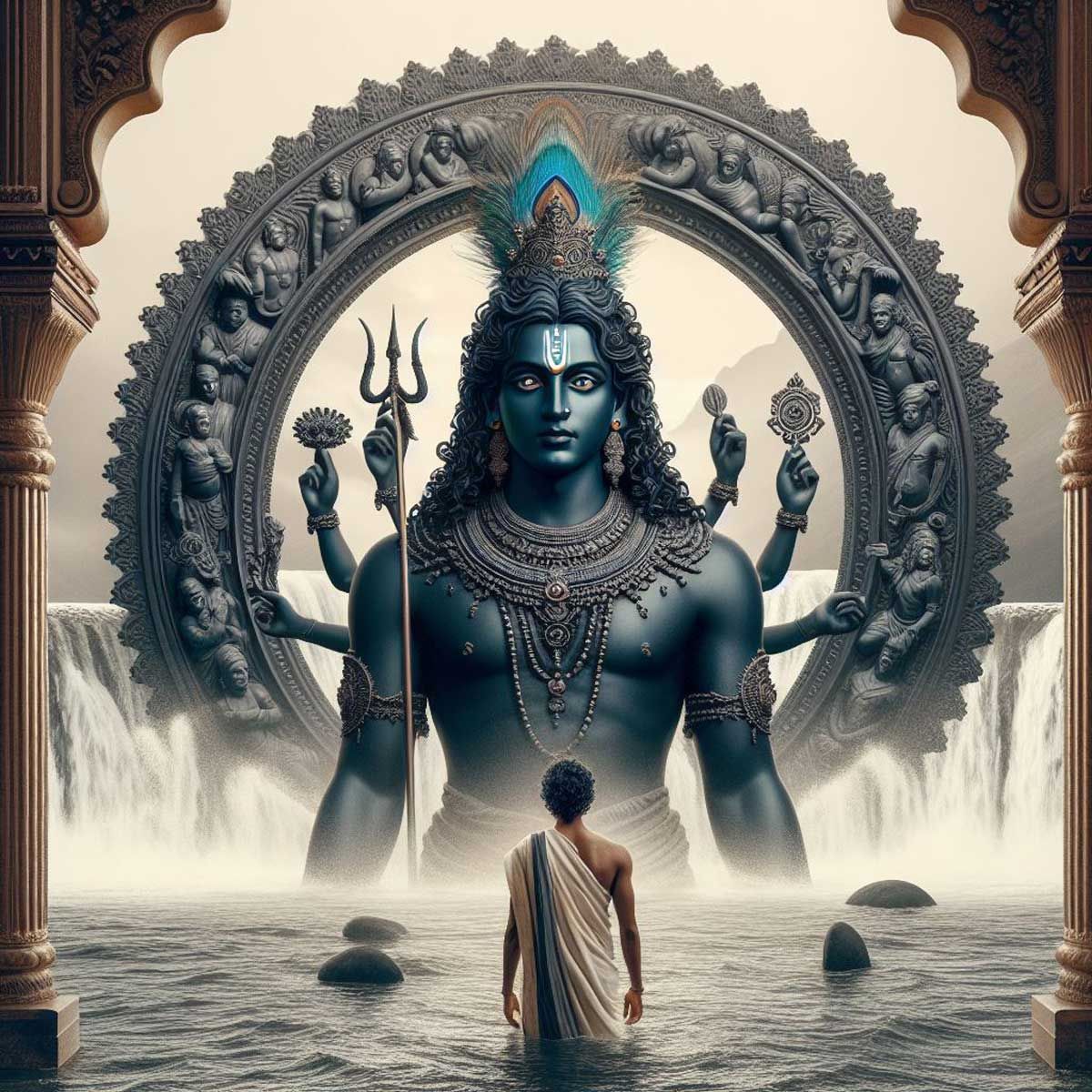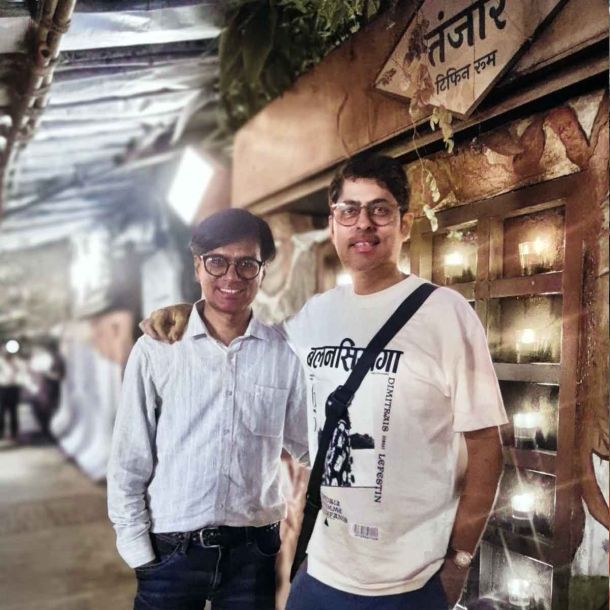More Coverage
Twitter Coverage
Satyaagrah
Written on
Satyaagrah
Written on
Satyaagrah
Written on
Satyaagrah
Written on
Satyaagrah
Written on
JOIN SATYAAGRAH SOCIAL MEDIA
"ॐ नमो नारायणाय नमः": In Karnataka's Krishna River, a 1000-year-old Lord Vishnu idol, featuring all ten Dashavatara around its aura and holding a chakra, alongside a Shivling, has been unearthed, revealing rich cultural heritage and ancient craftsmanship

In a remarkable discovery on February 7th, the depths of the Krishna River near Devasugur village in Karnataka's Raichur district revealed treasures of ancient significance. An idol of Lord Vishnu, adorned with depictions of all ten incarnations around its aura, alongside a Shivling, was unearthed. This idol of Lord Vishnu not only captivates with its intricate craftsmanship but also draws parallels to the recently consecrated statue of Lord Ram at Ayodhya's Ram Mandir, hinting at a deep-seated cultural and historical connection.
|
|
The belief that these idols were intentionally buried to safeguard them from Islamic invaders adds a layer of historical intrigue to the find. It suggests a tumultuous period where efforts were made to protect and preserve cultural heritage against external threats.
The discovery occurred amidst construction activities for a bridge over the Krishna River near Shaktinagar. The construction crew, upon stumbling upon these artifacts, took immediate steps to secure them and notified the local authorities, ensuring their preservation.
Archaeologists who later examined these artifacts have dated them back to the eleventh or twelfth century AD, underscoring their historical value and significance. This find not only highlights the rich cultural tapestry of Karnataka but also opens new avenues for understanding the region's historical resilience and the lengths to which its people went to protect their sacred symbols.
|
Continuing the captivating narrative of the recent archaeological find in Karnataka, Dr. Padmaja Desai, a lecturer in ancient history and archaeology at Raichur University, provided invaluable insights into the significance of the unearthed Lord Vishnu idol. According to Dr. Desai, this idol likely graced the sanctum sanctorum of a temple, its final resting place in the Krishna River marking a moment of crisis—perhaps the temple's destruction at the hands of invaders.
The idol, a remarkable piece from the Krishna basin, stands out for its unique depiction of the "Dashavatara" or the ten incarnations of Lord Vishnu. These include Matsya, Koorma, Varaha, Narasimha, Vamana, Rama, Parashurama, Krishna, Buddha, and Kalki, encircling the deity in an arc. This distinctive design mirrors that of the Ram Lalla idol in Ayodhya's Ram Mandir, surrounded by an arc illustrating the Dashavatara along with other deities.
Dr. Desai further described the idol's physical attributes, noting that Lord Vishnu is represented with four limbs in a standing posture. The lower hands are positioned in gestures of blessing (kati hasta and varada hasta), while the upper hands hold the "shankha" (conch) and "chakra" (disk), iconic symbols associated with the deity. This particular portrayal draws parallels to Venkateshwara as delineated in the Vedas, suggesting a deep-rooted connection to classical Hindu texts and traditions.
Dr. Padmaja Desai further elucidated on the artistic finesse of the Lord Vishnu idol, emphasizing that "The standing posture of the idol adheres intricately to the guidelines set forth in the Agamas, resulting in a beautifully crafted representation." This adherence to ancient scriptural guidelines highlights the sculptor's dedication to traditional norms and the spiritual significance embedded in the idol's creation.
|
An intriguing aspect of this idol is its deviation from conventional depictions of Lord Vishnu. Typically, Vishnu is accompanied by Garuda, his venerated mount. However, this idol features a pair of women holding fans instead, a variation that adds a unique charm to its portrayal. Dr. Desai pointed out the idol's cheerful demeanor, adorned with garlands and other decorations, reflective of Vishnu's affinity for such embellishments.
The idol's historical and cultural context is further illuminated by its condition and material composition. Despite some damage to its nose, the statue remains largely intact, suggesting it was possibly submerged in the river to protect it during an assault on its temple. "The stones used to carve the idols are green mixed rock," Dr. Desai noted, hinting that the idols might date back to the era of the Kalyana Chalukyas, a significant period in South Indian history.
This connection is underscored by the mention that the statue of Ram Lalla in Ayodhya was crafted from Shyamal stone from Karnataka, mirroring the origins of the Vishnu idol. This cross-reference not only ties the recent discovery to broader narratives of Indian artistry and devotion but also to the shared heritage of stone sculpture across different regions of India.
The responsibility for further examination and preservation of the Vishnu idol and Shivling has been transferred to the Archaeological Survey of India (ASI). With ongoing studies, these artifacts promise to unveil more about their origins, the craftsmanship of the Kalyana Chalukya period, and the enduring legacy of spiritual and artistic expressions in India's rich tapestry of history.
|
Unearthing of Ancient Vishnu Idol in Karnataka Echoes Ram Lalla's Consecration in Ayodhya
This extraordinary find, coinciding with the recent 'Pran Pratishtha' of the Ram Lalla idol in Ayodhya, feels less like coincidence and more like a divine orchestration, connecting the dots of devotion across time and space.
The 'Pran Pratishtha' ceremony, a ritual of consecrating idols, breathed life into the Ram Lalla idol, marking a historic moment of reverence and joy in Ayodhya. Similarly, the emergence of the Lord Vishnu idol from the river's depths seems to echo this sacred practice, as if the river itself performed a 'Pran Pratishtha' for the ages. The idol, featuring Lord Vishnu surrounded by an arc depicting his ten incarnations—similar to the design of the Ram Lalla idol—serves as a tangible link to the devotion and artistic expression that have flourished in India for centuries.
It's speculated that these artifacts were submerged in the Krishna riverbed for protection during tumultuous times, possibly from Islamic invasions, safeguarding them from destruction. Their recovery now, particularly at a time when the nation celebrates the installation of the Ram Lalla idol, feels like a miraculous revelation, a reminder of the enduring power of faith and the timeless legacy of India's spiritual guardianship.
The idols' appearance during the bridge construction near Shakti Nagar can be seen as a symbol of bridging the past with the present, uncovering layers of history that continue to inform and inspire the future. The fact that the Vishnu idol, adorned with garlands and smiling benevolently, was found intact except for some damage to its nose, speaks volumes about the resilience of spiritual heritage, surviving through centuries to emerge at a time when its presence could resonate so profoundly with current events.
The craftsmanship of the idol, adhering to the guidelines set forth in the Agamas and carved from green mixed rock indicating its origins in the Kalyana Chalukya's era, highlights the sophisticated artistry and deep reverence for divine representations that characterized ancient Indian culture. This discovery, much like the Pran Pratishtha ceremony in Ayodhya, reinvigorates the connection between the divine and the devotees, offering a moment of reflection on the continuity of devotion through the ages.
As these idols have now been entrusted to the Archaeological Survey of India for further study, one can only anticipate the additional insights and discoveries that await. The parallels between this find and the recent celebrations in Ayodhya underscore a shared spiritual narrative, a testament to India's rich tapestry of faith and its miraculous manifestations across time.
 |
 Support Us
Support Us
Satyagraha was born from the heart of our land, with an undying aim to unveil the true essence of Bharat. It seeks to illuminate the hidden tales of our valiant freedom fighters and the rich chronicles that haven't yet sung their complete melody in the mainstream.
While platforms like NDTV and 'The Wire' effortlessly garner funds under the banner of safeguarding democracy, we at Satyagraha walk a different path. Our strength and resonance come from you. In this journey to weave a stronger Bharat, every little contribution amplifies our voice. Let's come together, contribute as you can, and champion the true spirit of our nation.
 |  |  |
| ICICI Bank of Satyaagrah | Razorpay Bank of Satyaagrah | PayPal Bank of Satyaagrah - For International Payments |
If all above doesn't work, then try the LINK below:
Please share the article on other platforms
DISCLAIMER: The author is solely responsible for the views expressed in this article. The author carries the responsibility for citing and/or licensing of images utilized within the text. The website also frequently uses non-commercial images for representational purposes only in line with the article. We are not responsible for the authenticity of such images. If some images have a copyright issue, we request the person/entity to contact us at This email address is being protected from spambots. You need JavaScript enabled to view it. and we will take the necessary actions to resolve the issue.
Related Articles
- "Festivals are like a map charting our spiritual progress in God": India is a land of temples and unique rituals, one such followed by devotees in a Karnataka Temple is Agni Keli, symbolizing the victory of good over evil integral to our cultural heritage
- "When we bring what is within out into the world, miracles happen": Built by the Rajput king Sawai Jai Singh II in 1734, UNESCO World Heritage site Jantar Mantar, Jaipur is an astronomical observatory, which features the world’s largest stone sundial
- In a significant discovery Hindu temple structure with ornate columns found inside a mosque in Mangaluru, locals suspect the presence of a temple in the past: VHP leaders asked to stop work till documents verified
- “The blunders are all there on the board, waiting to be made”: Chess was born out of the India before 600s AD from 'Chaturanga' as a battle formation mentioned in Mahabharata, referring to 4 divisions of an army - elephantry, chariotry, cavalry & infantry
- "Sringara Prakasa - Sanskrit poetry": Classical theater, dancers (Bharatanatyam, Odissi, Mohiniyattam) refer to Sringara as 'the Mother of all rasas, one of the nine rasas, usually translated as erotic love, romantic love, or as attraction or beauty
- "Words on a page can hypnotize you if the rhythm is right": “Kalinga narthana” literally means “Kalinga dance” in Sanskrit, referring to a legend in which Shri Krishna, as a young boy, danced on the serpent Kaliya to stop him from poisoning Yamuna river
- "Movement of formless to form - Shivalinga": Supreme manifested as God through a threefold manifestation of Shaiva iconography, first manifestation Para-Shiva, second Sadashiva and third Mahesha, iconography started during Kushan period
- Why India’s temples must be freed from government control
- "Embrace the light within and discover the boundless expanse of enlightenment": IIT Kanpur, renowned for its remarkable advancements in science and technology embarks on a sacred endeavor to digitize and disseminate Indian philosophical texts, and Vedas
- "Neglect will drive a noble mind to depart for another land": Brilliant mind - Dr Subhash Mukhopadhyay who created India's first and world's second test tube baby 'Durga' in 1978 with the help of some general equipment and refrigerator was punished for it
- Birsa Munda: The tribal folk hero who was God to his people by the age of 25
- Chronicles of Valour- The Battle of Haldighati
- "In my prayers I never said I needed a home. I said I wanted a sanctuary": Sanctuary of Truth, Pattaya - an incredible 105-tall temple made entirely out of wood to honor Buddhist and Hindu values while preserving traditional Thai wood-carving techniques
- Savitri Devi broke into tears when Yogi Adityanath decided to leave for Gorakhpur to take vow of sainthood, and today her eyes contain the same tears brimming with pride Yogi has emerged as a Chief Minister of Uttar Pradesh
- For the first time in the history of Tirupati, 30 devotees on foot stopped from reaching temple for carrying musical instruments up Tirumala hill by TTD: Devotees perform Nama Sankeerthanam during the journey




























